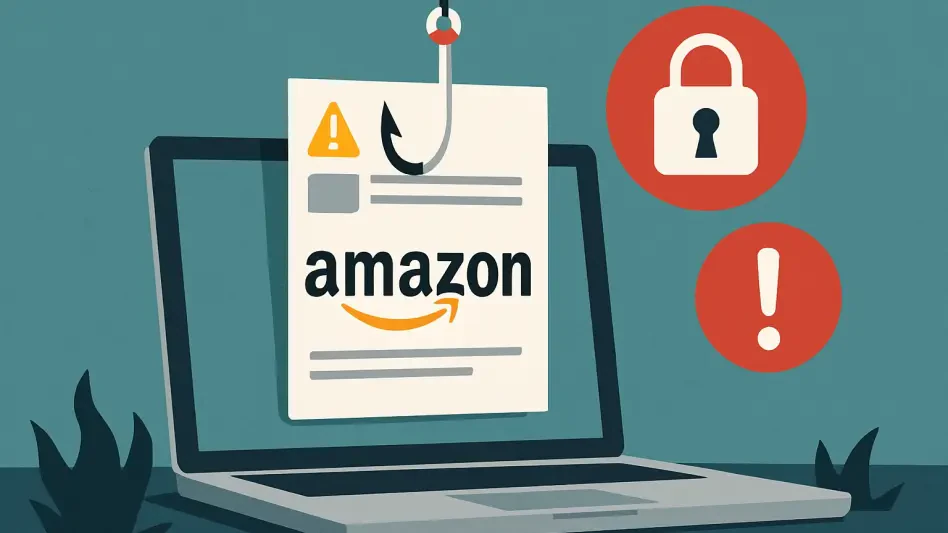In an era where online shopping dominates daily life, the security of accounts on platforms like Amazon has never been more critical, especially as cybercriminals ramp up their efforts to exploit unsuspecting users with increasingly sophisticated phishing scams. Reports of fraudulent messages promising refunds or exclusive deals have skyrocketed, tricking countless individuals into revealing their login credentials on deceptive websites. These attacks not only jeopardize personal information but also erode trust in digital commerce. As scammers adapt their tactics at an alarming rate, the need for robust security measures becomes undeniable. This pressing issue affects millions of users who rely on Amazon for everything from household essentials to luxury purchases. Understanding the nature of these threats and taking proactive steps to safeguard accounts is no longer optional but a necessity in today’s digital landscape, where a single lapse in vigilance can lead to significant financial and personal losses.
Rising Threat of Phishing Attacks
The surge in phishing scams targeting Amazon users is a stark reminder of how cybercriminals exploit trust in well-known brands to deceive individuals. Fraudulent text messages and emails, often promising refunds for recent purchases, lure users to fake sign-in pages meticulously designed to mimic the real Amazon interface. These scams have seen an unprecedented increase, with security firms noting rapid spikes in new variants within mere days of their emergence. The goal is clear: to steal credentials and gain unauthorized access to accounts. This trend highlights a growing challenge in distinguishing legitimate communications from malicious ones, as attackers refine their methods to appear more convincing. Users often fall prey to these schemes due to the urgency or familiarity conveyed in the messages, making it imperative to scrutinize every interaction that prompts for personal information, no matter how authentic it may seem.
Beyond the immediate risk of credential theft, these phishing attacks often lead to broader financial and identity-related consequences that can haunt victims for years. Once scammers obtain login details, they can drain bank accounts linked to Amazon profiles, make unauthorized purchases, or even sell the compromised data on the dark web for further exploitation. The scale of this issue is compounded by the sheer volume of users on the platform, making it a prime target for cybercriminals seeking high returns with minimal effort. Security experts emphasize that the rapid evolution of these scams requires constant vigilance, as attackers continuously adapt to bypass traditional warning signs. Public awareness campaigns by consumer protection agencies stress the importance of recognizing red flags, such as unsolicited messages or suspicious URLs, to prevent falling into these traps. Staying informed about the latest phishing tactics remains a critical defense in this ongoing battle against digital deception.
Vulnerabilities of Password-Only Security
Relying solely on passwords for Amazon account protection is a glaring vulnerability in an age where data breaches and infostealer campaigns are commonplace. Weak or reused passwords are often the first point of failure, as they can be easily compromised through breaches on unrelated platforms and then tested across multiple services by cybercriminals. Security analysts point out that attackers use automated tools to check stolen or common passwords at scale, putting accounts at significant risk. Studies consistently show that many users opt for predictable combinations, such as personal references like pet names or favorite sports teams, which are easily guessable with minimal effort. This widespread issue of poor password hygiene underscores the urgent need for stronger security practices to counter the sophisticated methods employed by modern attackers.
The limitations of password-only systems are further exacerbated by the sheer availability of breached credentials on underground markets, where hackers trade vast databases of stolen information. Even strong passwords can become liabilities if exposed in unrelated incidents, leaving users vulnerable without additional layers of protection. Research from cybersecurity firms reveals that millions of accounts remain at risk due to outdated security habits, with many individuals unaware of the dangers of reusing credentials across platforms. This gap in awareness allows cybercriminals to exploit human error as a primary entry point into otherwise secure systems. Addressing this issue requires a fundamental shift in how users approach account security, moving beyond the outdated notion that a single password can suffice. Emphasizing the adoption of enhanced measures is not just a recommendation but a critical step to mitigate the persistent threat of unauthorized access.
Amazon’s Push for Enhanced Security Measures
In response to the escalating cyber threats, Amazon has taken a proactive stance by advocating for advanced security features to protect user accounts from phishing and unauthorized access. The company strongly recommends enabling two-step verification (2FA), which adds an additional layer of defense by requiring a secondary form of authentication beyond a password. Additionally, Amazon promotes the use of Passkeys, a modern alternative that leverages biometric or device-based authentication for a more seamless and secure login experience. While these features are not mandatory for all accounts, the company provides detailed resources to guide users through the setup process. This commitment to consumer protection reflects a broader industry trend toward multi-factor authentication as a standard safeguard against the evolving tactics of cybercriminals.
Amazon’s efforts extend beyond technical solutions, focusing also on educating users about the risks of phishing scams and the importance of reporting suspicious activity. Through public awareness initiatives, the company aims to empower individuals to recognize fraudulent communications and take swift action to secure their accounts. This dual approach of offering robust tools like 2FA and fostering a culture of vigilance aligns with recommendations from security experts who stress the shared responsibility between platforms and users in combating cybercrime. Despite these measures, the fact remains that many accounts still rely solely on passwords, leaving a significant portion of users exposed to potential breaches. Bridging this gap requires ongoing efforts to encourage the adoption of advanced security options, ensuring that every user is equipped to face the sophisticated threats that target high-value platforms like Amazon on a daily basis.
Building a Stronger Defense Against Cybercrime
The dynamic nature of cyberattacks targeting Amazon users demands a multi-layered defense strategy that goes beyond traditional security practices. Phishing scams, with their ability to adapt quickly to user behavior and platform updates, pose a persistent challenge that cannot be addressed through passwords alone. Security experts advocate for a combination of technological safeguards and behavioral changes to create a robust barrier against unauthorized access. This includes regularly updating passwords to unique, complex combinations and staying alert to unsolicited messages that prompt for personal information. By integrating tools like 2FA and Passkeys with a heightened sense of caution, users can significantly reduce their risk of falling victim to these deceptive schemes that exploit trust and urgency.
Looking ahead, the fight against cybercrime requires continuous adaptation to keep pace with the innovative tactics employed by attackers seeking to compromise Amazon accounts. Reflecting on past efforts, initiatives to educate users about phishing risks and promote advanced security features have laid a strong foundation for safer online experiences. However, the journey does not end there; it evolves into a call for sustained action. Users are urged to take immediate steps by reviewing their account settings and enabling additional protections like 2FA. Staying informed about emerging threats through trusted sources becomes a vital habit. As the digital landscape shifts, the focus turns to fostering a proactive mindset, ensuring that every individual remains equipped to navigate future challenges with confidence and security in an ever-changing environment.








